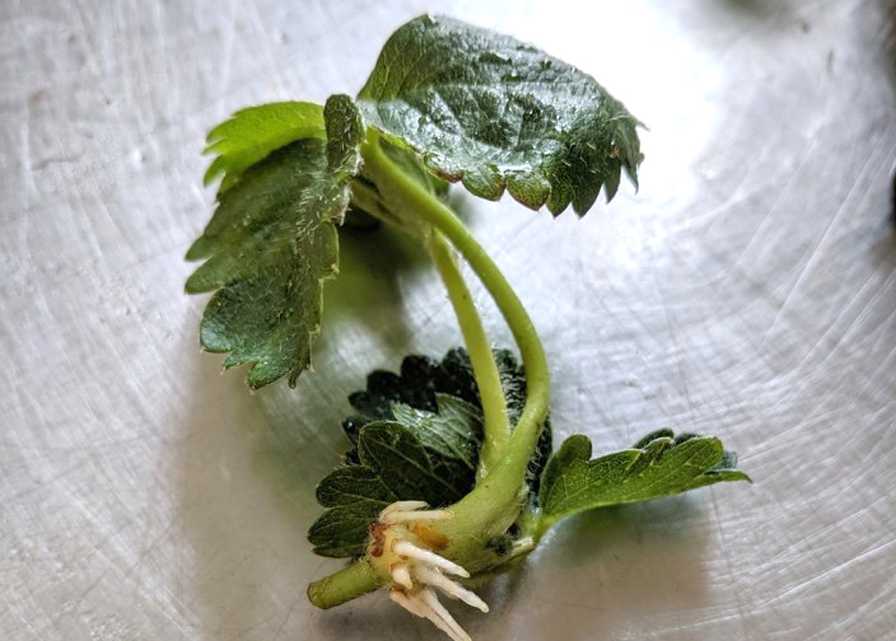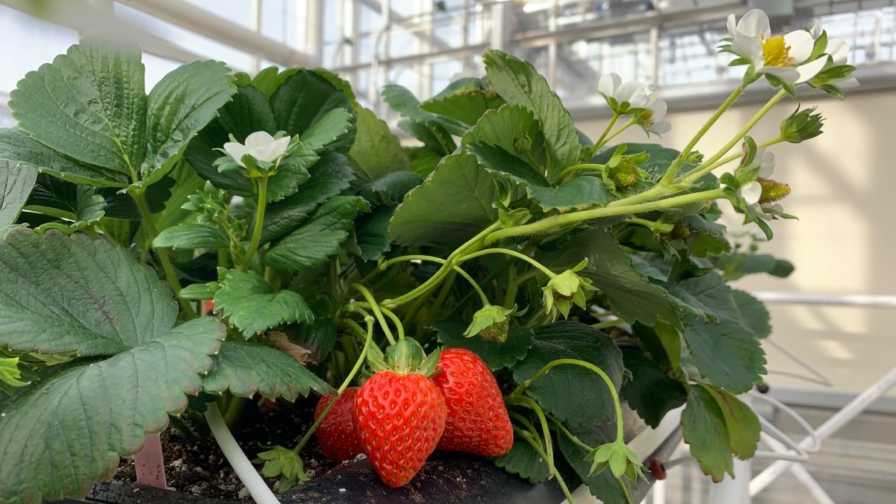From Planting To Harvesting: The Basics of Indoor Strawberry Production
In just the past few years, both historically field berry companies as well as many indoor controlled environment agriculture (CEA) growers have begun to try their hand at growing strawberries indoors. Strawberries, however, have much different needs than more familiar indoor crops like leafy greens and herbs. This article will detail some of the important considerations for starting up and maintaining a productive indoor strawberry crop based on years of experience at Cornell University.
The first step is to decide whether to grow a short-day (aka June-bearing) variety or a day-neutral variety strawberry. For short-day varieties, the plants are typically purchased pre-chilled so they are primed and ready to flower shortly after transplanting. The plants will produce two to three rounds (flushes) of fruit. However, after these two or three flushes of fruit, the plants need to be taken out and replaced with new plants. This type of variety allows for a large amount of fruit to be produced in a short amount of time; however, it also requires much more energy and labor replacing plants frequently.
On the other hand, day-neutral varieties can be planted out at the grower’s leisure, and once the plants are large enough, they will begin flowering and fruiting. The plants can continuously produce fruit for six months to a year, depending on the level of maintenance of the plants.
Choosing the Right Varieties
The decision to grow a short-day variety or a day-neutral variety should be based on the grower’s market and labor supply. Once this decision has been made, the grower then needs to decide what specific variety of strawberry to grow. This decision should be influenced by the environment in which the crop is to be grown and the environment in which the crop was developed. Strawberry breeders/suppliers are an excellent resource for finding cultivars well-suited for the grower’s specific climate.
It is also important to take into consideration that many of the popular commercial cultivars are under license, which means that a fee must be paid to propagate these plants. Although there is a higher cost to using these cultivars, they tend to have the most modern and preferred plant and fruit characteristics. Also, there are essentially no CEA-specific cultivars that are readily available in the U.S., which means it may take some trial and error to figure out which varieties work best in a grower’s specific indoor environment.
At Cornell University, we have selected day-neutral cultivars ‘Albion’ and ‘Cabrillo’. ‘Albion’ is sweeter but lower yielding than ‘Cabrillo’. Both perform well with day/night temperature of 72°F/58°F. Cooler night temperatures (50°F to 54°F) would give larger berry size, but can be hard to achieve outside of winter.
Once a varietal decision has been made, the plant material must be purchased. For short-day varieties, rooted runner plugs can be purchased that have been pre-chilled to induce flower bud initiation. For day-neutral varieties, growers can purchase bare-root plants or propagate their own plants from runners. Purchased bare-root plants are dug from fields and held in a cooler for up to several months. These plants are quite small and must typically be transplanted and grown for a few months before they can be transplanted into final strawberry gutters for rooting. Alternatively, a grower may purchase rooted runner tips from greenhouse propagation beds or propagate their own from mother plants. This practice can lead to cleaner plants (i.e., plants without soil-borne diseases or insects).

Figure 1: Plantlet with peg roots harvested from a runner.
Photo courtesy of Cornell University
Proper Rooting Is Critical
If propagating one’s own plants, grow mother plants in troughs high above the ground and allow the runners to hang down. Once the plantlets on each runner begin to produce small white peg roots, the runners can be harvested off of the mother plants and the individual plantlets cut so that each plantlet has peg roots, at least two leaves, and about 1 inch of stem (Figure 1). These plantlets should then be put into individual cells of a plug flat that is filled with a good porous media (such as a peat: perlite mix, or a coco coir mix). Do not plant too deep, as strawberries are sensitive to crown rot. The flat should then be placed in a warm, humid, shaded environment until the plantlets have rooted out and are ready for transplant into the growing system (about three to six weeks) (Figure 2). Fogging or periodic misting should be used to maintain high relative humidity, especially during the first couple weeks of rooting.

Figure 2: Successfully propagated plants.
Photo courtesy of Cornell University
Strawberry root systems are extremely sensitive to low oxygen and thus need to be planted into a very well-drained media. Research and practice have not yet shown effective deep-water culture or NFT strawberry production, so we recommend using substrate culture. Typical grow systems for indoor strawberry production include pots or trough systems, or bag/slab culture similar to what is typically used in high-wire tomato systems. There are pros and cons to both systems; however, as long as the media is well-drained, either system should work well.
The plants should be irrigated often for a short amount of time with a leachate factor of approximately 20%. An example of an effective irrigation scheme is to water every day, five times a day, for three minutes per watering, with a half-gallon per hour emitter. Strawberry plants are very water efficient and overwatering could easily lead to crown rot or root rot. Strawberries are also sensitive to high salts in the root-zone/fertilizer. A nutrient solution EC of 1.2 mS/cm will be effective in most cases, but the EC as well as the nutrient recipe can be changed as the plant goes from vegetative to generative growth.
Use Caution When Harvesting
For large-scale production, fruit should be harvested at least three times per week. The fruit can be harvested by hand by either twisting and breaking the berry off of the stem or by cutting with scissors. If the berries are to be stacked, then the stem should be clipped as close to the berry as possible. It is important to note that strawberries grown indoors tend to be softer than those grown outdoors; however, the flavor and sweetness tends to be much greater. The fruit can be harvested directly into its retail packaging, but due to the softness of the berry, innovative packaging should be used that reduces the contact between berries.
It is also imperative to cool the berries as quickly as possible to have the longest shelflife. Additionally, one tip for increasing the firmness, flavor, and sugar content of the berries is to increase the temperature differential between day and night temperatures.

Figure 3: Well-pruned strawberry plants in a trough system.
Photo courtesy of Cornell University
On the days when the fruit is not being harvested, the plants need to be maintained. This maintenance includes removing any runners that are produced; reducing the number of crowns to a maximum of three per plant; reducing the number of inflorescences to a maximum of four; and thinning the number of flowers per truss to only the primary, secondary, and in some cases tertiary flowers (depending on plant size and target berry size). These pruning steps will ensure that the fruit are all of sufficient size and that the plants aren’t overwhelmed by the energy needed to produce the vegetative and generative material (Figure 3).
As one can see, there is much that growers will need to learn to run a successful indoor strawberry operation. However, a productive and healthy system can produce a high-yielding, very delicious, high-value product.
More Information Online
Another great background resource for growing strawberries in a greenhouse comes from the strawberry production information at The Ohio State University. Go to https://u.osu.edu/indoorberry to learn more.










